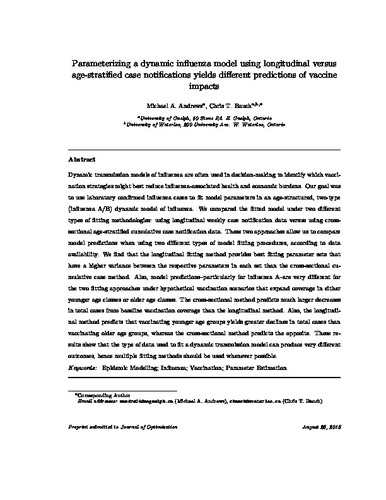| dc.contributor.author | Andrews, Michael A. | |
| dc.contributor.author | Bauch, Chris T. | |
| dc.date.accessioned | 2018-09-06 15:00:55 (GMT) | |
| dc.date.available | 2018-09-06 15:00:55 (GMT) | |
| dc.date.issued | 2018-09-06 | |
| dc.identifier.uri | http://hdl.handle.net/10012/13756 | |
| dc.description | Preprint submitted to the Journal of Optimization | en |
| dc.description.abstract | Dynamic transmission models of influenza are often used in decision-making to identify which vaccination strategies might best reduce influenza-associated health and economic burdens. Our goal was to use laboratory confirmed influenza cases to fit model parameters in an age-structured, two-type (influenza A/B) dynamic model of influenza. We compared the fitted model under two different types of fitting methodologies: using longitudinal weekly case notification data versus using cross-sectional age-stratified cumulative case notification data. These two approaches allow us to compare model predictions when using two different types of model fitting procedures, according to data availability. We find that the longitudinal fitting method provides best fitting parameter sets that have a higher variance between the respective parameters in each set than the cross-sectional cumulative case method. Also, model predictions–particularly for influenza A–are very different for the two fitting approaches under hypothetical vaccination scenarios that expand coverage in either younger age classes or older age classes. The cross-sectional method predicts much larger decreases in total cases from baseline vaccination coverage than the longitudinal method. Also, the longitudinal method predicts that vaccinating younger age groups yields greater declines in total cases than vaccinating older age groups, whereas the cross-sectional method predicts the opposite. These results show that the type of data used to fit a dynamic transmission model can produce very different outcomes, hence multiple fitting methods should be used whenever possible. | en |
| dc.description.sponsorship | Natural Sciences and Engineering Research Council (NSERC) Individual Discovery Grant | en |
| dc.language.iso | en | en |
| dc.subject | Epidemic Modelling | en |
| dc.subject | Influenza | en |
| dc.subject | Vaccination | en |
| dc.subject | Parameter Estimation | en |
| dc.title | Parameterizing a dynamic influenza model using longitudinal versus age-stratified case notifications yields different predictions of vaccine impacts | en |
| dc.type | Preprint | en |
| dcterms.bibliographicCitation | Andrews, M. A., & Bauch, C. T. (2018). Parameterizing a dynamic influenza model using longitudinal versus age-stratified case notifications yields different predictions of vaccine impacts. [preprint] | en |
| uws.contributor.affiliation1 | Faculty of Mathematics | en |
| uws.contributor.affiliation2 | Applied Mathematics | en |
| uws.typeOfResource | Text | en |
| uws.peerReviewStatus | Unreviewed | en |
| uws.scholarLevel | Faculty | en |

